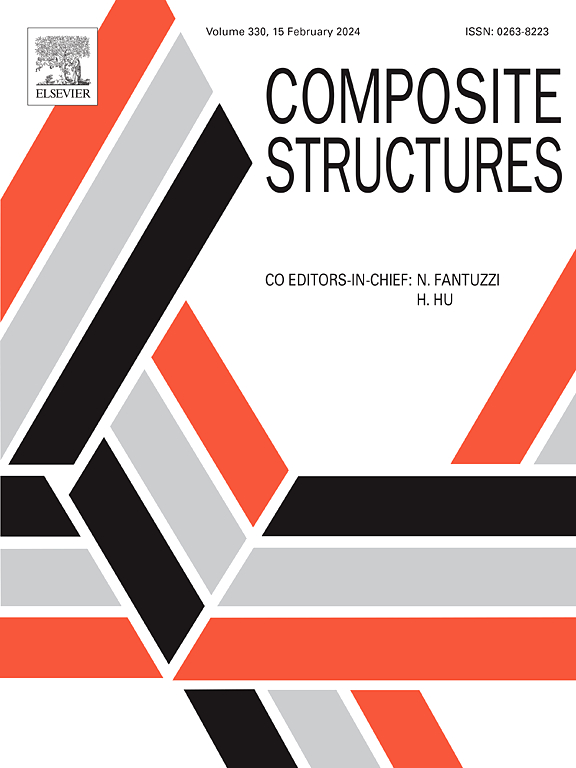具有错位堆叠蛛网状声波晶体芯的薄夹芯板的振动抑制特性
IF 6.3
2区 材料科学
Q1 MATERIALS SCIENCE, COMPOSITES
引用次数: 0
摘要
本研究提出了一种新颖的蛛网状多孔变截面声子晶体(VCSPC),并采用错位堆叠法构建薄夹层板,以实现轻质、紧凑的低频振动抑制结构。研究采用有限元法(FEM)分析了带隙(BG)特性和振动模式。为了验证错位堆叠方法的有效性,对频率响应函数(FRF)进行了有限元模拟和实验验证。结果表明,具有分布式质量和周期性变化横截面的蛛网状构造可以降低 BG 的开口频率。与传统的线性排列面板相比,错位堆叠结构表现出同等的振动 BG 和衰减特性。值得注意的是,错位堆叠设计大大减小了振动衰减方向上的尺寸。这种薄型夹层板非常适合对减振结构尺寸有限制的工程环境。所提出的策略有助于利用大规模声子晶体进行低频振动控制,从而通过更紧凑的结构设计促进声子晶体在工程中的应用。本文章由计算机程序翻译,如有差异,请以英文原文为准。
Vibration suppression characteristics of a thin sandwich panel with misaligned stacking spider-web-like phononic crystal cores
A novel spider-web-like multi-hole variable cross-section phononic crystal (VCSPC) is proposed in this study, along with a misaligned stacking approach for constructing thin sandwich panels to achieve lightweight and compact structures for low-frequency vibration suppression. The band-gap (BG) characteristics and vibration modes are analyzed using the finite element method (FEM). To validate the effectiveness of the misaligned stacking approach, the finite element simulation and experimental verification of the frequency response function (FRF) are conducted. The results demonstrate that the spider-web-like configuration, with distributed masses and periodically varying cross-sections, can reduce the opening frequencies of BGs. When compared to the conventional linearly arranged panel, the misaligned stacking structure exhibits equivalent vibration BGs and attenuation characteristics. It is important to note that the misaligned stacking design significantly reduces the size in the direction of vibration attenuation. This type of thin sandwich panel is well-suited for engineering environments with size limitations on vibration reduction structures. The proposed strategy facilitates the use of large-scale phononic crystals for low-frequency vibration control, thereby promoting the application of phononic crystals in engineering through a more compact structural design.
求助全文
通过发布文献求助,成功后即可免费获取论文全文。
去求助
来源期刊

Composite Structures
工程技术-材料科学:复合
CiteScore
12.00
自引率
12.70%
发文量
1246
审稿时长
78 days
期刊介绍:
The past few decades have seen outstanding advances in the use of composite materials in structural applications. There can be little doubt that, within engineering circles, composites have revolutionised traditional design concepts and made possible an unparalleled range of new and exciting possibilities as viable materials for construction. Composite Structures, an International Journal, disseminates knowledge between users, manufacturers, designers and researchers involved in structures or structural components manufactured using composite materials.
The journal publishes papers which contribute to knowledge in the use of composite materials in engineering structures. Papers deal with design, research and development studies, experimental investigations, theoretical analysis and fabrication techniques relevant to the application of composites in load-bearing components for assemblies, ranging from individual components such as plates and shells to complete composite structures.
 求助内容:
求助内容: 应助结果提醒方式:
应助结果提醒方式:


